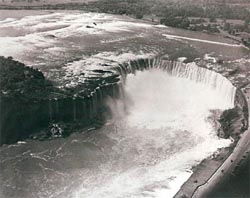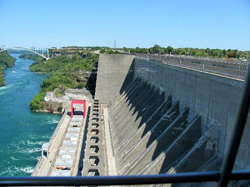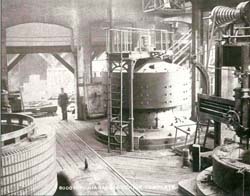Higgins on the Mark: Albany Stealing Hydropower Benefits
By Frank Parlato
Niagara Falls’ new congressman, Brian Higgins showed he is not misguided when it comes to understanding the long-term impact of the New York State Power Authority (NYPA) on this region.
“Over the past six years, NYPA and NYS have taken over $1 billion from the Niagara Power Project to fund operations elsewhere,” Higgins said last week. “In 2008 alone, NYPA had a surplus of $309 million; $236 million, 76%, of this came from the Niagara.”
By elsewhere, he means in effect New York City and that NYPA is supported by the Niagara power plant to the tune of almost a quarter of a billion in profits per year.
“NYPA studies, released prior to relicensing, found that only 14% of the economic benefit from the Niagara Power Project remains in WNY,” said Higgins.
Said another way, Albany successfully took 86 percent of the benefits of having hydropower out of the region.
“Historically, it was the abundant source of hydropower that led to the rise of the chemical and manufacturing industry in Niagara Falls,” says Higgins, the first politician brave enough to actually call NYPA out on its destructive policies.
What Higgins might add, because it is demonstrably true, is that the loss of 86 percent of locally-produced, inexpensive hydropower is the reason we lost 37,000 jobs since NYPA took over 50 years ago. Industry stayed until the inexpensive power went away.
“The Niagara Power Project is the key to NYPA’s profitability,” said Higgins. “No other place in the State can provide what Niagara Falls can.”
What Higgins might care to ask is why should Niagara Falls support the rest of the state’s hydro power and get little or nothing in return?
Higgins sounds a bit sanguine when he says, “NYPA can and should choose to be a partner in this City’s rise once again,” for this is a partnership that can never work predicated as it is on the region receiving 14 percent or less of the benefit from the hydro power in their midst. The power is local, but our “partner” believes it belongs to them.
Let us look at some stunning realities to demonstrate that a partnership with NYPA is impossible:
First: There is no cheap electrical power in Niagara Falls. Search around the globe, and you won’t find another instance of this: A place where they generate billions of dollars worth of any essential commodity such as electricity and the locals don’t get that commodity inexpensively.
According to Electric Power Monthly, 98 percent of the nation pays less than what we pay for electricity.
Twenty-five percent of the nation pays less than half of what we pay.
You ask yourself, “why are we paying 44 percent more for electricity than the residents of Sarasota, Fla.,” which does not have the advantage of a natural power source nor the disadvantage of high heating bills?
Where else could you find a place that produces billions (quarter of a billion? half a billon?) worth of a commodity that everybody uses -- a commodity that once made them rich -- who signed their rights away for 50 years, saw it exported at cheap prices, then paid exorbitantly for the same commodity, descending during this time from prosperous to poverty?
Who elects leaders that -- when their first, bankrupting, 50-year deal was up -- sign another 50-year deal?
Suppose a region grew apples so red and delicious that they were famous for it. They got rich from their sale; healthy from eating – but somehow the people and their children – for 50 years - never tasted them, or even profited (unless, of course, they moved away - which many of them did). Then these people and their leaders renewed the license of the “Apple Authority” to have dominion over their apples, and, for another 50 years, they imported more expensive, inferior apples, or went without apples, though the orchards were all around them. They could smell the scent of the blossoms; they could tour the orchards and see apples hanging thick on the trees. But they could not eat the apples.
Their greatest asset was to be used by others.
Hearken back, my friends, to its genesis, to 1957, when Robert Moses told the people how NYPA having exclusive control of Niagara's hydropower would ensure continued prosperity in this region. A skillful liar, Moses deceived an innocent, trusting, prosperous people into the loss of their asset and left a legacy of riches to ruin.
We were told we needed NYPA to manage our power to make sure the people, and not a few, greedy, corporate barons or political patronage hogs, got the benefit.
Although it was created by the New York State Legislature to provide “low-cost electricity to the people of New York,” NYPA became instead a political institution. NYPA’s Board of Directors, appointed by Albany politicians with no direct accountability to the people, for decades accommodated thousands of back-door, sweetheart deals --at the behest of politicians-- that systematically diverted and denuded every vestige of benefit of having hydropower in our midst.
Instead of providing low cost electricity as we were promised, which would have created thousands of good-paying jobs, the profits from our hydropower instead paid for administrative jobs in Albany and White Plains.
In 1956, the year before NYPA took over, Compton’s Encyclopedia wrote: “Water power helped build the (prosperous) city of Niagara Falls … the falling of water provides a great and constant source of power for (locally-owned) hydro-electric plants which supply the city and surrounding area (with) abundant and cheap electrical power.”
In 2013, the people who have the greatest natural hydropower in the world have neither control, nor use of that power, nor inexpensive electricity.
In 2007, we might have regained local control. But a group called the Niagara Power Coalition, comprised of representatives of Niagara Falls, Niagara County, the towns of Niagara and Lewiston, and the Niagara-Wheatfield, Lewiston-Porter, and Niagara Falls school districts, agreed to another 50-year license for NYPA, until 2057 - a century without power - in return for a pittance: $233 million, paid over 50 years, and a tiny allocation of low-cost Niagara power, which politicians, of course, get to control.
We relinquished, on behalf of current and future residents of this county, a potential billion-dollar-a-year asset in return for a seven-way split of $5 million annually.
Since it is not factored for inflation, it will be $5 million, split seven ways, 44 years from now. Compared to the value of Niagara power, $5 million is five cents.
The City of Niagara Falls gets $850,000 of this annual $5 million. That $850,000 never increases and is never adjusted for inflation. When Mayor Paul Dyster wanted to sell the 44 years remaining at $850,000 per year, NYPA offered a paltry $13 million for it.
For all rights to all our local hydropower for 44 years – a billion per year asset – NYPA only had to pay $13 million.
NYPA executives know, of course, that ignorance in Niagara is bliss for Albany.
They do not have to provide Niagara power to the people. The people here don’t even know they don’t get their power from the falling waters of the Niagara.
Many think that the NYPA power plants are here, and that NYPA offers free tours of the power vista and free parking for waterfowl observation, that NYPA is providing electricity for them too.
Niagara residents get their power from burning coal and other inefficient methods, purchased at a high mark-up from a company owned by investors from England called National Grid. We buy expensive electricity from the British, while NYPA takes our locally produced, inexpensive hydropower and sells it to New York City.
The only waterfowl that the NYPA executives see are, lamentably, colorful geese living in homes around the area that have such assets but never demand the right to benefit as every prosperous place in the world would do.
There is no exception to that rule, anywhere in history: a region must benefit from its local, natural advantages just as it must pay for its natural disadvantages.
The time has come when the people must investigate their right to break the deal with NYPA. If we had half the courage of the Seneca Indians, who burn tires and blockade roads when they perceive injustice, and stand up to the state like they were so many tin-men, we could start a movement to take our power back.
We might go down in history as the “Power City” – who, with so many assets lost, stood up and restored our power.
We could start an action on behalf of the people to condemn NYPA’s property based on the deception perpetrated by Robert Moses. He said NYPA control of our hydropower would prove a boon to Niagara. That was his contract with us, his governing covenant.
When Niagara lost control of its hydropower, it impoverished itself.
Indeed, Niagara Falls lost its two greatest assets to Albany: Tourism (through Albany's aggressive me-first business style management of the state park) and the power theft.
Imagine what your life would be if you were to be deprived of the use or the profit from your two greatest assets? Whatever you do best in life, your two greatest, shining talents, imagine what life would be like if someone took all the profit away from the use of those?
Congressman Higgins recommends that stakeholders in Niagara Falls consider objecting to the Federal Energy Regulatory Commission’s approval of the renewal of NYPA’s relicensing of its Blenhiem Gilboa power plant in the Catskills, which is up for renewal in 2019, and for which, Higgins says, the Niagara power plant subsidized $62 million.
It is a start, perhaps. But more drastic measures are needed. Higgins may be the one elected official who will help do it.
Meantime, there is no inexpensive electrical power for the people who live where electricity is generated. If you want cheap electricity, if you want this city to rise again, we have to elect the leaders who are prepared to condemn NYPA.
To kick them out!
For the public good, as the only method to take our power back, NYPA must be condemned.
After all, every region, like every person, has the right to prosper from their natural assets.




